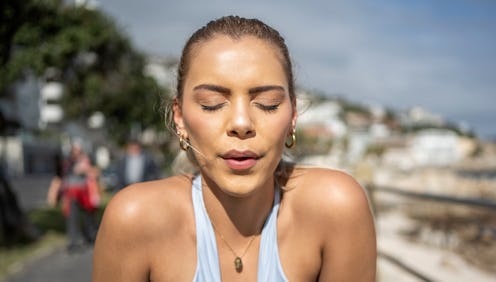Wellness
"Pursed Lip" Breathing Is The Quickest Way To Calm Stress & Anxiety
The small, simple technique has a big impact on your stress levels.

If you deal with stress or anxiety, then you know you can never have too many breathwork techniques in your self-care repertoire. The latest one that’s taking over TikTok? “Pursed lip” breathing, which has racked up over 16 million views. It’s the smallest, simplest change you can make to your usual inhales and exhales, but it has a big impact on your stress levels.
Pursed lip breathing quite literally involves breathing out through tight, pursed lips — kind of like you’re blowing out a candle, only slower.
“When you purse your lips while exhaling, it creates a bit of resistance,” says Carrie Torn, LCSW, a licensed therapist in North Carolina. “This slows down the exhale, allowing for a more extended breath out.”
When you slow down your breathing rate — especially the exhale portion — it helps get your parasympathetic nervous system back into balance, which in turn helps you feel calm and safe as opposed to panicked and stressed, says Dr. Geri-Lynn Utter, Psy.D., a clinical psychologist based in Philadelphia.
It’s a good technique to try if you’re feeling on edge before a big moment, like a test or a meeting, and it also helps with everyday anxiety that seems to pop up out of nowhere. Here’s what to know about pursed lip breathing and how to give it a try.
The Power Of Pursed Lip Breathing
When you’re feeling anxious, it’s common to either hold your breath or to breathe in and out too quickly with panicky gasps. According to Utter, both habits signal to your body that you’re in danger — even when you aren’t — and ultimately make your anxiety worse.
A pursed lip exhale is a guaranteed way to slow down your breathing rate, which is what shortcircuits the fight-or-flight response.
“The extended exhale gives your parasympathetic nervous system more time to understand that you aren’t in an actual threat,” says Utter. “When you’re anxious, the brain often needs a minute to calculate that you’re going to be OK, and the longer breath out is what gives your brain time to catch up.”
Pursed lip breathing helps regulate your breathing pattern, too, which makes it more efficient while reducing the feeling of breathlessness, Torn tells Bustle. “That’s why this breathing technique is often recommended for people with COPD as well.”
As a bonus, it also lowers your heart rate, and that’s a must when it comes to chilling out. “When your heart rate comes down, your body starts to feel less threatened and it helps calm your brain,” Utter adds.
How To Do The Technique
Torn recommends trying this breathing technique when you aren’t anxious, just to see what it feels like. “After practicing, you can then use it in higher times of stress,” she says.
- Relax your neck and shoulders.
- Purse your lips as if you're going to whistle.
- Breathe in gently through your nose for a count of two.
- Purse your lips and breathe out slowly and evenly through them for a count of four or more. Think about blowing out through a straw or as if you are going to blow out candles.
- Feel free to adjust the inhale and exhale counts to what feels right for you — just make sure the exhale is longer than the inhale.
- Practice for a few minutes, gradually extending the exhale.
Combine It With Mindfulness
To make the most of a pursed lip breath, Utter recommends pairing it with deep diaphragmatic breathing. “For better results, take a deep breath into your stomach as opposed to your chest, and breathe out through pursed lips,” she says. “This will slow you down even more.”
While you’re at it, add in a dose of mindfulness, too. Try to be present in the moment by noticing what’s going on around you as you breathe. Acknowledge that your anxiety is tough to deal with, but tell yourself that you’ll get through it, says Utter. Keep these reassuring thoughts on repeat in your head, and you’ll be relaxed in no time.
Studies referenced:
Fincham, G. W. (2023). Effect of breathwork on stress and mental health: A meta-analysis of randomised-controlled trials. Scientific Reports, 13(1), 1-14. https://doi.org/10.1038/s41598-022-27247-y
Hopper, SI. (2019). Effectiveness of diaphragmatic breathing for reducing physiological and psychological stress in adults: a quantitative systematic review. JBI Database System Rev Implement Rep. doi: 10.11124/JBISRIR-2017-003848.
Komori, T. (2018). The relaxation effect of prolonged expiratory breathing. Ment Illn. doi: 10.4081/mi.2018.7669.
Mayer, AF. (2018). Effects of acute use of pursed-lips breathing during exercise in patients with COPD: a systematic review and meta-analysis. Physiotherapy. 2018 Mar;104(1):9-17. doi: 10.1016/j.physio.2017.08.007.
Nguyen, JD. (2023). Pursed-lip Breathing. In: StatPearls [Internet]. Treasure Island (FL): StatPearls Publishing; 2023 Jan-. Available from: https://www.ncbi.nlm.nih.gov/books/NBK545289/.
Vlemincx, E. (2016). A sigh of relief or a sigh to relieve: The psychological and physiological relief effect of deep breaths. Physiol Behav. doi: 10.1016/j.physbeh.2016.07.004.
Sources:
Dr. Geri-Lynn Utter, Psy.D., clinical psychologist
Carrie Torn, LCSW, licensed therapist